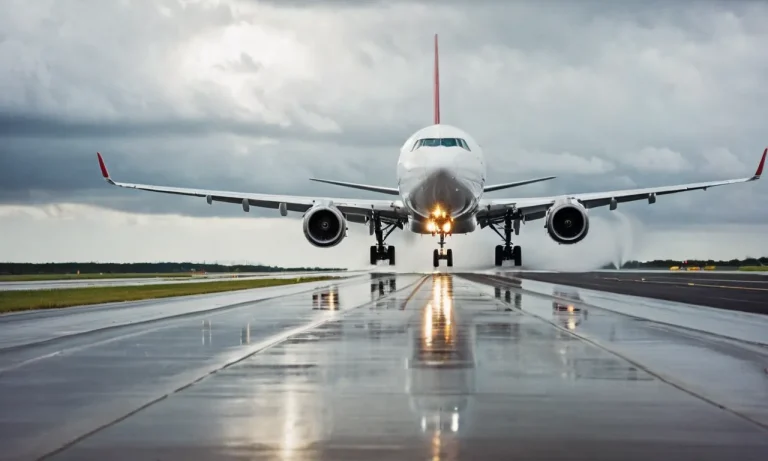Can You Drive From Alaska To Russia?
The idea of driving from Alaska across the Bering Strait to Russia is an intriguing one that captures the imagination and sense of adventure. If you’re short on time, here’s a quick answer: Currently there is no road connecting Alaska and Russia that would allow you to drive between the two.
In this comprehensive guide, we’ll cover everything you need to know about the feasibility and requirements for driving from Alaska to Russia. We’ll look at the history behind the concept, challenges like the climate and geography that need to be overcome, visa and legal considerations, as well as speculation around future road projects that could potentially bridge the two continents.
Background and History Behind the Idea
The idea of driving from Alaska to Russia may sound outlandish, but it is not entirely far-fetched. The concept is rooted in the geographical proximity of the Bering Strait, which separates the two continents. Here is a look at the background and history behind this intriguing idea.
Early Exploration of the Bering Strait Region
The exploration of the Bering Strait region dates back to the 18th century when Russian explorers began venturing across the strait from Siberia to Alaska. The most famous of these explorers was Vitus Bering, a Danish explorer commissioned by the Russian Empire.
Bering’s expedition in 1728-1730 laid the foundation for future exploration and paved the way for the idea of connecting the two continents.
Fun Fact: Did you know that the Bering Strait is named after Vitus Bering? It is a testament to the significance of his exploration in this region.
Proposals for an Alaska-Siberia Highway
In recent years, the idea of a highway connecting Alaska and Siberia has gained attention. Although it is still just a concept, several proposals have been put forward to make this ambitious project a reality.
One proposal suggests the construction of a tunnel beneath the Bering Strait, similar to the Channel Tunnel connecting England and France. This tunnel would allow for both vehicle and rail traffic, providing a direct link between North America and Asia.
Another proposal involves building a bridge across the Bering Strait, connecting the city of Nome in Alaska with Provideniya in Russia. This bridge would span over 50 miles, making it one of the longest bridges in the world.
Interesting Fact: The proposed bridge would encounter significant engineering challenges due to the harsh Arctic climate and the need to withstand seismic activity in the region.
While these proposals are still in the realm of speculation, the idea of driving from Alaska to Russia captures the imagination of many. It would not only be a remarkable engineering feat but also a symbol of connection and unity between two continents.
Authoritative Website: For more information on the Bering Strait region and its exploration history, visit the National Park Service website: https://www.nps.gov/bela/index.htm
Geographic Challenges to Connecting Alaska and Russia by Road
While the idea of driving from Alaska to Russia might seem intriguing, there are several significant geographic challenges that make it nearly impossible. Let’s explore some of these challenges:
The Bering Strait
The Bering Strait, located between Alaska and Russia, presents the most significant obstacle to connecting the two regions by road. Spanning approximately 50 miles, this narrow strait is filled with icy waters and unpredictable currents.
It would be extremely challenging, if not impossible, to construct a bridge or tunnel across such a vast expanse of water.
Furthermore, the Bering Strait is a vital migration route for numerous marine species, including whales and seals. Any attempt to build a road would disrupt these delicate ecosystems and harm the wildlife that relies on this area for survival.
Climate and Environmental Conditions
The extreme climate and harsh environmental conditions in both Alaska and Russia also pose significant challenges. The region experiences long, harsh winters with freezing temperatures and heavy snowfall.
These conditions make it difficult to maintain a road infrastructure that can withstand the constant freeze-thaw cycles and heavy snow accumulation.
In addition, the remote and isolated nature of the area makes it challenging to provide necessary services, such as emergency response, fuel stations, and rest areas, along a potential road route. The lack of infrastructure and support systems would make such a journey dangerous and impractical.
Terrain and Lack of Infrastructure
The terrain in both Alaska and Russia is rugged and unforgiving. The vast stretches of wilderness, mountains, and tundra would require extensive and costly engineering efforts to build a road capable of withstanding the challenging terrain.
Moreover, the lack of existing road infrastructure in remote areas would make it difficult to connect existing road networks, further adding to the complexity of the project.
It’s worth mentioning that the idea of connecting Alaska and Russia by road has been contemplated for many years. However, due to the numerous challenges and the significant financial investment required, no serious plans have been put into action.
While the concept of driving from Alaska to Russia may be intriguing, the geographic challenges, including the Bering Strait, climate and environmental conditions, and the rugged terrain, make it an unrealistic endeavor.
For now, the most practical way to travel between these two regions remains by air or sea.
Political and Legal Considerations for Crossing the Borders
When it comes to driving from Alaska to Russia, there are several political and legal considerations that need to be taken into account. These considerations include visa requirements for both Russians and Americans, as well as regulations surrounding driving foreign vehicles.
Visa Requirements for Russians and Americans
Before attempting to drive from Alaska to Russia, it is important to understand the visa requirements for both Russians and Americans. Russian citizens would need to obtain a visa to enter the United States, and Americans would also need a visa to enter Russia.
It is crucial to research and comply with the specific visa requirements and application processes of both countries.
For more information on visa requirements for Russians traveling to the United States, visit the official website of the U.S. Department of State: https://travel.state.gov/content/travel/en/us-visas.htmlFor information on visa requirements for Americans traveling to Russia, visit the official website of the Embassy of the Russian Federation: https://www.russianembassy.org/
Regulations Around Driving Foreign Vehicles
In addition to visa requirements, there are regulations and restrictions surrounding driving foreign vehicles in both Russia and the United States. These regulations may vary depending on the specific region or state that you plan to drive through.
It is important to research and comply with the local laws and regulations regarding foreign vehicle importation, registration, and insurance.
Driving a vehicle across international borders can be a complex process. It is recommended to consult with the respective customs and border control authorities of both countries to ensure that you have the necessary documentation and permits to drive from Alaska to Russia.
For more information on driving regulations in the United States, visit the official website of the U.S. Department of Transportation: https://www.transportation.gov/For information on driving regulations in Russia, visit the official website of the Russian Ministry of Transport: https://www.mintrans.ru/
It is important to note that the feasibility of driving from Alaska to Russia may also depend on geopolitical factors and the availability of infrastructure, such as roads and border crossings. It is always recommended to stay updated on current travel advisories and consult with local authorities before attempting such a journey.
Ongoing and Future Proposals for an Alaska-Siberia Highway
For decades, the idea of a road connecting Alaska to Russia has captured the imagination of adventurers and dreamers. While such a road may seem like a far-fetched idea, several proposals have been put forward to make this ambitious project a reality.
A Tunnel Under the Bering Strait
One of the most intriguing proposals is the construction of a tunnel under the Bering Strait, connecting Alaska to Siberia. This would create a direct land route between North America and Asia, spanning over 50 miles of treacherous waters.
The tunnel would allow vehicles to travel between Alaska and Russia, opening up new trade routes and fostering cultural exchange between the two regions.
The idea of a Bering Strait tunnel is not new. In fact, it was first proposed by Tsar Nicholas II of Russia in the early 20th century. Since then, various feasibility studies have been conducted, considering factors such as geology, engineering challenges, and cost.
While the project would undoubtedly be a massive undertaking, it has the potential to revolutionize transportation and strengthen economic ties between the two countries.
The Western Hemisphere Route Initiative
Another proposal gaining traction is the Western Hemisphere Route Initiative, which aims to connect Alaska to the rest of the Americas through an extensive highway network. This ambitious plan would involve the construction of roads spanning thousands of miles, connecting Alaska to the lower 48 states and eventually reaching as far south as Argentina.
The Western Hemisphere Route Initiative envisions a network of highways that would promote tourism, trade, and cultural exchange between countries in the Americas. It would provide a scenic and adventurous route for travelers, offering breathtaking views of diverse landscapes and facilitating the movement of goods and services across borders.
Challenges Facing Approval and Construction
While the proposals for an Alaska-Siberia highway are exciting, there are numerous challenges that need to be addressed before construction can begin. Environmental concerns, such as the impact on fragile ecosystems and wildlife habitats, would need to be carefully considered and mitigated.
Additionally, securing funding for such a massive infrastructure project would require the cooperation and support of multiple governments and international organizations.
Furthermore, there are logistical challenges associated with building a highway in remote and harsh environments. Extreme weather conditions, permafrost, and difficult terrain would all need to be navigated during the construction process.
Additionally, the sheer scale of the project would require extensive planning and coordination to ensure its success.
While the idea of driving from Alaska to Russia may still seem like a distant dream, ongoing proposals and initiatives are bringing us closer to the possibility. With careful planning, innovation, and international cooperation, the construction of an Alaska-Siberia highway could create a historic connection between continents and open up new opportunities for trade, travel, and cultural exchange.
Conclusion
While a drive from Alaska across the Bering Strait to Russia is currently impossible given the lack of roads and gap between the continents, the concept continues to fire up the imagination. Ambitious infrastructure projects propose bridging the two lands, but face immense financial, engineering and legal obstacles.
Even if a route does open one day, drivers would still face harsh climate and road conditions, regulations around border crossings and vehicle documentation. But the opening of such a road would undoubtedly be an iconic feat of human engineering and connection.








